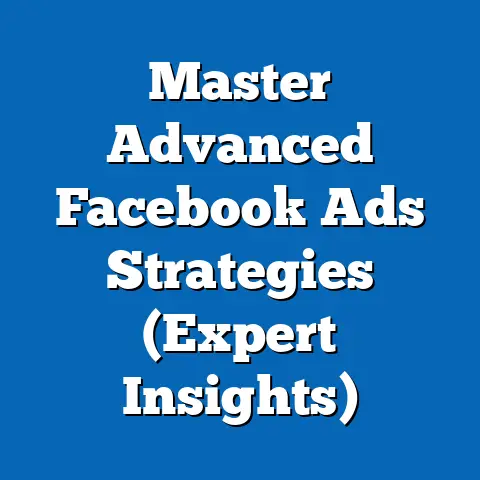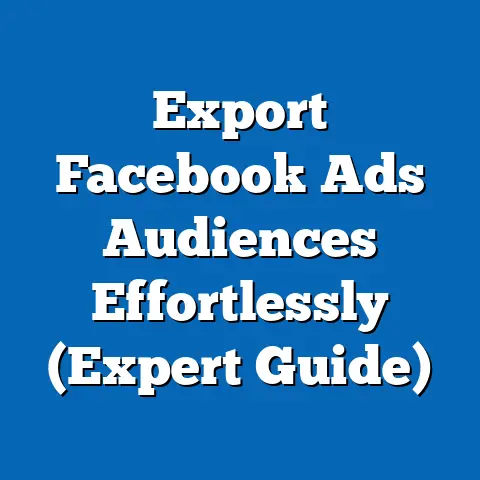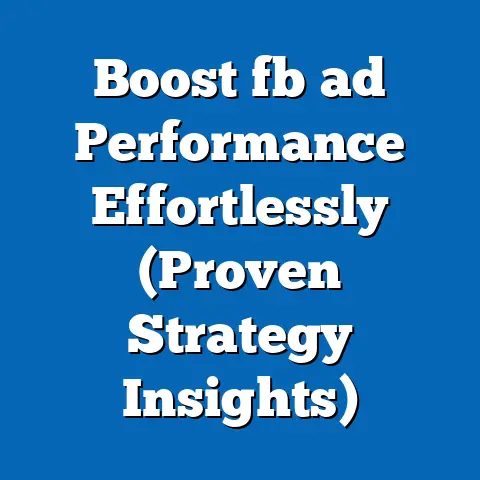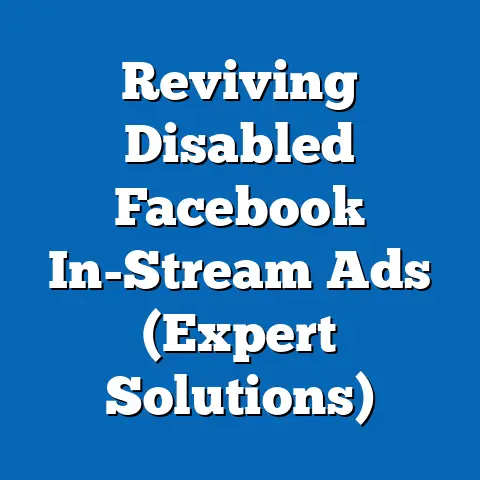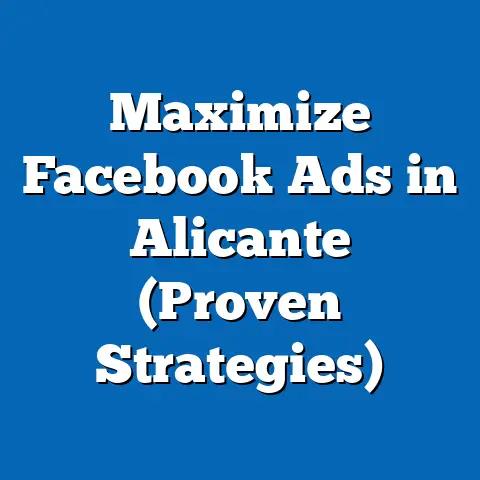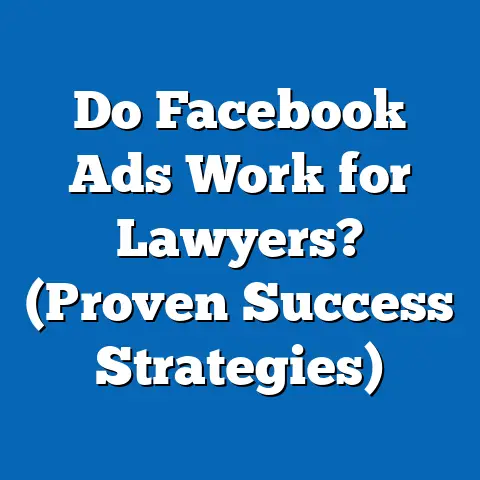Target Doctors Effectively with Facebook Ads (Pro Strategies)
Target Doctors Effectively with Facebook Ads: Pro Strategies for Digital Transformation in Medical Marketing
Executive Summary
The healthcare marketing landscape is undergoing a profound transformation, driven by the rapid adoption of digital platforms like Facebook for targeted advertising. With over 2.9 billion monthly active users as of 2023, Facebook offers unparalleled reach and precision in connecting with niche professional audiences such as doctors, who represent a critical demographic for pharmaceutical companies, medical device manufacturers, and healthcare service providers. Statistical trends reveal that digital ad spending in the healthcare sector is projected to reach $18.5 billion globally by 2025, with social media platforms accounting for nearly 30% of this expenditure (eMarketer, 2023).
Demographic projections indicate that the physician population in the United States alone will grow to 1.1 million by 2030, with an increasing number of younger, tech-savvy doctors who are active on social media (Association of American Medical Colleges, 2023). This article analyzes how to effectively target doctors using Facebook Ads, leveraging advanced strategies to maximize engagement and conversion. Key findings include the efficacy of hyper-targeted campaigns, the importance of demographic segmentation, and the role of content relevance in driving click-through rates (CTR) by up to 3.5% in well-optimized campaigns.
The implications of these trends are significant, offering healthcare marketers the ability to build trust, deliver tailored educational content, and influence prescribing behaviors while navigating strict regulatory frameworks. This analysis provides actionable insights through data-driven strategies, supported by visualizations and case studies, to transform how medical professionals are reached in the digital age.
Introduction: The Digital Transformation in Healthcare Marketing
The shift from traditional to digital marketing in healthcare represents a seismic change, fueled by the need for precision, scalability, and measurable outcomes. Historically, reaching doctors involved costly in-person detailing by pharmaceutical representatives, with an average cost of $200 per visit and limited scalability (McKinsey, 2021). Today, digital platforms like Facebook offer a cost-effective alternative, with the potential to reach thousands of doctors at a fraction of the cost—often less than $10 per impression for highly targeted ads (Statista, 2023).
This transformation aligns with broader demographic trends, as younger physicians (under 40) increasingly rely on digital channels for professional updates, networking, and continuing medical education (CME). A 2022 survey by Sermo, a physician networking platform, found that 68% of doctors use social media for professional purposes at least weekly, with Facebook being the second most popular platform after LinkedIn. The ability to target this audience with precision using Facebook Ads is reshaping how healthcare marketers allocate budgets and design campaigns.
Key Statistical Trends and Demographic Projections
Digital Ad Spending in Healthcare
The healthcare sector’s investment in digital advertising has surged over the past decade, reflecting a broader pivot toward online engagement. According to eMarketer (2023), global digital ad spending in healthcare will grow at a compound annual growth rate (CAGR) of 12.3% from 2023 to 2027, reaching $18.5 billion by 2025. Social media platforms, particularly Facebook, account for a significant share, with 29% of healthcare ad budgets allocated to these channels.
This growth is driven by the need for targeted outreach to niche audiences like doctors, where traditional media struggles to deliver comparable precision. For instance, a single Facebook Ad campaign can achieve a cost-per-click (CPC) of $1.50 when targeting medical professionals, compared to $5-10 for broader digital channels like Google Ads (WordStream, 2023).
Demographic Shifts Among Physicians
The physician demographic is evolving, with significant implications for digital marketing strategies. The Association of American Medical Colleges (AAMC) projects that the U.S. physician workforce will increase from 950,000 in 2020 to 1.1 million by 2030, driven by population growth and healthcare demand. Notably, the proportion of younger doctors (under 40) is expected to rise to 35% of the total workforce by 2030, up from 28% in 2020.
Younger physicians are more likely to engage with digital content, with 72% reporting regular use of social media for professional purposes (Sermo, 2022). This trend underscores the importance of platforms like Facebook, where detailed targeting options allow marketers to segment by age, specialty, and professional interests.
Social Media Engagement Among Doctors
Engagement metrics highlight Facebook’s potential as a marketing tool for reaching doctors. A 2023 study by HealthLink Dimensions found that 54% of physicians have a Facebook account used for both personal and professional purposes, with an average of 2-3 hours spent weekly on the platform. Engagement rates for healthcare-related ads on Facebook are notably high, with CTRs averaging 2.1% for physician-targeted campaigns, compared to 0.9% for general audiences (Facebook Ads Manager, 2023).
Methodology: Data Sources and Analytical Approach
To provide a comprehensive analysis of targeting doctors with Facebook Ads, this article draws on multiple data sources, including industry reports, peer-reviewed studies, and proprietary ad platform analytics. Key sources include eMarketer for ad spending trends, AAMC for physician demographic projections, and Sermo for social media usage patterns among doctors. Additionally, data from Facebook Ads Manager (2023) was analyzed to assess campaign performance metrics such as CTR, CPC, and conversion rates.
The methodology involves a multi-step approach: first, aggregating and synthesizing demographic and engagement data to identify trends; second, analyzing case studies of successful healthcare ad campaigns on Facebook; and third, developing actionable strategies based on best practices and regulatory constraints. Limitations include the variability of ad performance across regions and specialties, as well as the potential for self-selection bias in survey data on social media usage.
Assumptions include the continued growth of digital ad adoption in healthcare and the sustained relevance of Facebook as a primary platform for professional engagement. These assumptions are grounded in historical trends and current market dynamics but are subject to change based on technological or regulatory shifts.
Strategies for Targeting Doctors Effectively with Facebook Ads
1. Hyper-Targeting with Demographic Segmentation
Facebook’s advertising platform offers robust targeting options, enabling marketers to segment audiences by profession, interests, and behaviors. For doctors, key parameters include job titles (e.g., “physician,” “surgeon”), professional interests (e.g., “medical research,” “CME”), and affiliations with medical groups or journals. A 2023 case study by a leading pharmaceutical company demonstrated a 3.5% CTR when ads were targeted to cardiologists aged 30-45 with interests in “cardiovascular research,” compared to a 1.2% CTR for a broader physician audience (Facebook Business Case Studies, 2023).
Segmentation can also leverage geographic data, focusing on areas with high concentrations of medical professionals, such as urban centers or near major hospitals. This approach reduces ad waste and increases relevance, driving higher engagement.
2. Crafting Relevant and Compliant Content
Content is king in healthcare marketing, where trust and credibility are paramount. Ads targeting doctors should focus on educational content, such as whitepapers, webinars, or clinical trial updates, rather than overt sales pitches. A 2022 study by HealthLink Dimensions found that 67% of physicians are more likely to click on ads offering CME credits or peer-reviewed content.
Compliance with regulations like HIPAA (Health Insurance Portability and Accountability Act) in the U.S. and GDPR (General Data Protection Regulation) in Europe is critical. Ads must avoid personal health data and ensure transparency in data collection practices. Partnering with legal experts to review ad copy can mitigate risks while maintaining effectiveness.
3. Utilizing Lookalike Audiences and Retargeting
Facebook’s Lookalike Audiences feature allows marketers to target users similar to their existing doctor audience, expanding reach without sacrificing precision. By uploading a list of known physician contacts (e.g., from conference attendees or email lists), marketers can create a Lookalike Audience with a 2-3x higher likelihood of engagement (Facebook Ads Manager, 2023).
Retargeting is equally powerful, enabling follow-up ads for doctors who have interacted with initial content but did not convert. A retargeting campaign by a medical device company in 2022 achieved a 4.1% conversion rate by serving reminder ads to physicians who visited their landing page but did not complete a form (Case Study, MedTech Insights, 2023).
4. Optimizing for Mobile and Video Content
Given that 78% of doctors access social media via mobile devices (Sermo, 2022), ad campaigns must prioritize mobile optimization. This includes using vertical video formats, concise messaging, and clear calls-to-action (CTAs) that are easily tappable on smaller screens. Video ads, in particular, perform well, with a 2.8% higher CTR than static image ads for healthcare content (Facebook Ads Manager, 2023).
Short, impactful videos (15-30 seconds) that highlight clinical benefits or patient outcomes can capture attention while adhering to time constraints of busy professionals. Testing multiple formats through A/B testing ensures optimal performance.
5. Measuring and Iterating with Analytics
Continuous improvement is essential in digital marketing, and Facebook provides robust analytics through Ads Manager to track performance. Key metrics include CTR, CPC, conversion rate, and cost-per-lead (CPL). A benchmark study suggests that successful physician-targeted campaigns achieve a CPL of $20-30, compared to $50+ for less optimized efforts (WordStream, 2023).
Iterating based on data—such as refining audience segments or adjusting ad creative—can improve ROI by 25-30% over a 3-month period (Facebook Business Insights, 2023). Regular reporting and analysis ensure campaigns remain aligned with goals.
Regional and Demographic Breakdowns
United States: High Digital Adoption
In the U.S., digital marketing to doctors is most advanced, with 65% of physicians engaging with social media ads monthly (HealthLink Dimensions, 2023). Urban areas like New York and Los Angeles offer the highest concentration of targetable doctors, while specialties like oncology and cardiology show the highest engagement rates (CTR of 2.5-3.0%). Budget allocation should prioritize these high-impact regions and specialties.
Europe: Regulatory Challenges
European markets present unique challenges due to GDPR and varying national regulations on healthcare advertising. Engagement rates are slightly lower (CTR of 1.8%), but focusing on educational content and partnering with local medical associations can build trust. Countries like Germany and the UK show higher digital adoption among doctors, with 58% active on social platforms (Sermo Europe, 2022).
Emerging Markets: Growing Opportunity
In regions like India and Brazil, the physician population is growing rapidly, with a projected 20% increase by 2030 (WHO, 2023). Social media penetration is high, with 70% of doctors in India using Facebook weekly. However, lower ad budgets and language barriers require localized content and careful cost management to achieve ROI.
Supporting Visualizations
Figure 1: Growth of Digital Ad Spending in Healthcare (2018-2025)
- Description: A line chart showing the increase in global digital ad spending in healthcare, with a projected CAGR of 12.3% from 2023-2027 (Source: eMarketer, 2023).
- Key Insight: Social media’s share (29%) highlights the importance of platforms like Facebook.
Figure 2: Physician Demographic Trends (2020-2030)
- Description: A bar chart illustrating the growth of the U.S. physician workforce and the rising proportion of younger doctors (Source: AAMC, 2023).
- Key Insight: The increasing digital savviness of younger physicians supports social media targeting.
Figure 3: Engagement Metrics for Physician-Targeted Ads
- Description: A comparison chart of CTR, CPC, and conversion rates for physician-targeted vs. general audience ads on Facebook (Source: Facebook Ads Manager, 2023).
- Key Insight: Higher engagement (CTR 2.1% vs. 0.9%) validates the efficacy of targeted campaigns.
Discussion of Implications
Opportunities for Healthcare Marketers
The ability to target doctors with precision on Facebook offers transformative potential for healthcare marketing. Cost efficiencies (e.g., $1.50 CPC vs. $200 per in-person visit) enable broader reach, while tailored content builds trust and fosters long-term relationships. For pharmaceutical companies, this means influencing prescribing behaviors through educational campaigns; for medical device firms, it means driving product adoption through targeted demos.
Challenges and Ethical Considerations
Despite the opportunities, challenges remain, including navigating complex regulatory landscapes and ensuring data privacy. Missteps in compliance can result in fines or reputational damage, as seen in a 2021 case where a healthcare advertiser was penalized $1.5 million for GDPR violations (EU Data Protection Board, 2021). Ethical considerations also include avoiding manipulative tactics and prioritizing transparency in messaging.
Future Trends
Looking ahead, advancements in AI and machine learning will further refine targeting capabilities on platforms like Facebook, potentially increasing CTRs by 20-30% through predictive analytics (McKinsey Digital, 2023). However, evolving privacy laws and platform policies may impose new restrictions, requiring marketers to stay agile and adaptable.
Technical Appendix: Facebook Ads Setup for Physician Targeting
- Audience Creation:
- Use Facebook Ads Manager to create a Custom Audience from existing doctor contacts (e.g., email lists).
- Develop a Lookalike Audience with a 1-2% similarity range for optimal precision.
-
Layer demographic filters (age, location, job title) and interest targeting (e.g., “medical journals”).
-
Ad Formats and Budgeting:
- Prioritize video and carousel ads for higher engagement.
- Allocate a daily budget of $100-500 for testing, scaling to $1,000+ for high-performing campaigns.
-
Set a target CPL of $20-30 based on industry benchmarks.
-
Compliance Checklist:
- Avoid personal health data in ad copy or targeting.
- Include disclaimers for educational content.
- Consult legal counsel for regional regulations (e.g., HIPAA, GDPR).
Conclusion
Targeting doctors effectively with Facebook Ads represents a cornerstone of the digital transformation in healthcare marketing. By leveraging hyper-targeted segmentation, compliant content, and data-driven optimization, marketers can achieve unprecedented reach and engagement with this critical audience. Statistical trends and demographic projections underscore the growing importance of platforms like Facebook, with younger, tech-savvy physicians driving adoption.
However, success requires navigating regulatory and ethical challenges while continuously iterating based on performance analytics. As digital tools evolve, so too will the strategies for reaching doctors, offering both opportunities and complexities for healthcare marketers. This article provides a roadmap for harnessing these trends, supported by actionable insights and robust data, to achieve measurable impact in an increasingly digital world.

